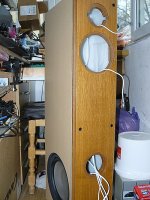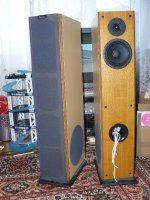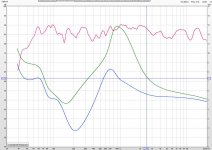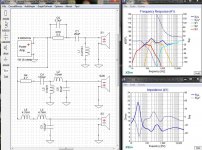Can you explain?
On datasheet the dome has 120W and the ring has only 100W.
It is only because the ring has a bigger coil?
I must have misread the data I thought the dome had 20W power handling! Time for some new glasses! 😀
In that case I would question whether the dome could actually be successfully crossed lower because of it's more than double x-max even though it's resonant frequency is slightly higher than the ring. At low power the ring may have the edge, but at higher power I would suspect the dome will be a better choice.
Tony.
Last edited:
But you Wintermute have heard these drivers, or at least one of them or is only.....a paper decision?
I need to send back one of these drivers and I need reasons.
I am still a beginner in speaker construction and I need a lot of advice.
I need to send back one of these drivers and I need reasons.
I am still a beginner in speaker construction and I need a lot of advice.
Hi sesebe sorry missed your question before. No I've not heard either of these tweeters, I was commenting purely on the physical specs, not from experience. Nice work! How do they sound?
Chris, thanks! I really should get out and do more night photography, I got a fantastic tripod for my birthday and have hardly used it!
Tony.
Chris, thanks! I really should get out and do more night photography, I got a fantastic tripod for my birthday and have hardly used it!
Tony.
I made some measurements and I was disappointed that at relatively low level on tweeter, I can see with REW the second harmonics for the 2Khz signal........
In rest the sound it is ok. Now I ran the drivers to grind them for measurements.
In rest the sound it is ok. Now I ran the drivers to grind them for measurements.
How many db down was the 2nd harmonic? Can you post the measurement? Was the tweeter tightly screwed into the baffle?
Tony.
Tony.
I don't save the measurement......I still wait to grind the them and after some tens of hours I will make a full set of measurement in a better location (an audio studio).
The speakers are fixed well on baffle.
The speakers are fixed well on baffle.
The level of harmonic was variable and direct dependent to the level of the fundamental signal. Until at a level was not visible but after this the harmonic was increasingly more and more as the fundamental growth.
I increased the level until the harmonics was at only 12db-18db less. I do not increased more then that.
I was not expected this from a brand tweeter.
Maybe the tweeter is bad? From the beginning?
I increased the level until the harmonics was at only 12db-18db less. I do not increased more then that.
I was not expected this from a brand tweeter.
Maybe the tweeter is bad? From the beginning?
Last edited:
Ok, I made some measurements with the full speaker.
It sound ok but I whant more. I will continue to test diferent filters configutrations.
With violet is the output,
with green is the impedance and
with blue is the impedance with the resistor R4=10ohm and placed after L3 coil. The amplifier was'n happy with this configuration.
It sound ok but I whant more. I will continue to test diferent filters configutrations.
With violet is the output,
with green is the impedance and
with blue is the impedance with the resistor R4=10ohm and placed after L3 coil. The amplifier was'n happy with this configuration.
Attachments
I had both, the Peerless has a very high price/performance ratio but same goes to the SB Acoustics. My choice would be the SB Acoustics model unless price is of serious considration. Besides that, the Peerless has pretty high Qts, they would not be interchangeable in the same designso one will fit better than the other.
PS: OK, sorry did not read the whole thread...
PS: OK, sorry did not read the whole thread...
Last edited:
Hello guys,
How to set the amplifier for correct gain measurement?
Considering 8 ohm speaker, it's OK to set to 2.8V?
2.8V RMS or peak to peak?
Thank you!
How to set the amplifier for correct gain measurement?
Considering 8 ohm speaker, it's OK to set to 2.8V?
2.8V RMS or peak to peak?
Thank you!
I tried a search on the forum but I got too many results with too little tangent related to my question.
Can you point me some relevant topics?
Can you point me some relevant topics?
With my software I simply measure an 8 Ohm speaker with known sensitivity, and adjust the soundcard volume to display the actual sensitivity of that 8 ohm speaker. I can also adjust the volume on amp if needed. when I've done this, I'm ready to measure any speaker for accurate sensitivity.
If I have amp volume set and don't change it for period of time, I can rely on that fixed soundcard output setting.
I can also adjust MIC sensing.
If I have amp volume set and don't change it for period of time, I can rely on that fixed soundcard output setting.
I can also adjust MIC sensing.
Last edited:
I have a oscilloscope, signal generator and DAC.
I also have a umik-1 microphone to not to rely on soundcard
The phone output of the DAC I use to measure the impedance.
I can check the level at the output of the amplifier with the scope but I need to know at what level to adjust it for a calibrated gain measurement.
I also have a umik-1 microphone to not to rely on soundcard
The phone output of the DAC I use to measure the impedance.
I can check the level at the output of the amplifier with the scope but I need to know at what level to adjust it for a calibrated gain measurement.
I can't understand why you feel the community needs calibrated SPL on a DIY speaker design? Unless I was publishing the specs for a distributor what other reason do I need to be closer than 1 db? Am I missing something?
Sent from my iPhone using Tapatalk
Sent from my iPhone using Tapatalk
- Status
- Not open for further replies.
- Home
- Loudspeakers
- Multi-Way
- speakers comparison



